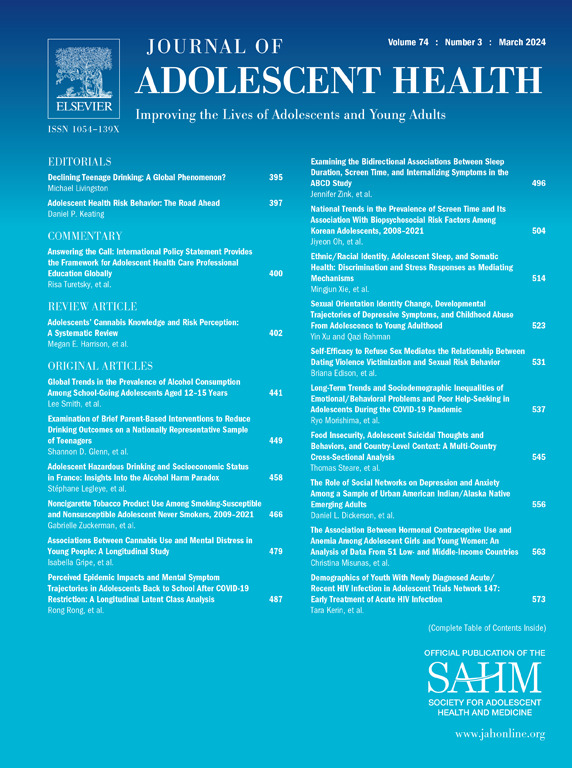烟草与健康人口评估(PATH)研究中从青春期前到青春期后期(2013-2020)电子烟和卷烟使用轨迹类别的时间特异性预测因子
IF 4.5
2区 医学
Q1 PEDIATRICS
引用次数: 0
摘要
目的:在美国,青少年使用电子烟比吸烟更普遍。在美国中学生中,任何尼古丁/烟草产品的使用都在上升。不同的因素可能驱动从易感性到启蒙的转变,而对青少年早期转变的了解较少。方法:数据来自烟草与健康人口评估(PATH)研究的第1波(W),横跨7波(2013-2020),从美国早期青少年(12-13岁)到年龄较大的青少年(18-19岁)。未加权的纵向潜在类别分析确定了电子烟和香烟易感性和使用在不同模型中的轨迹类别。加权多项逻辑回归分析检验了发散轨迹的时间特异性预测因子。结果:确定了5类电子烟(权重为45.1%从未使用,15.4%易感,6.9%仅开始使用,19.9% W5进展/停用,12.7%进展/持续)和4类香烟(权重为61.2%从未使用,21.3%易感,10.6% W4.5进展/停用,6.9%曾经使用)。在2020年(COVID-19大流行的第一年),观察到这两种产品的停止使用。只有电子烟模型确定了到2020年将持续使用的类别。日常社交媒体的使用和广告曝光对年轻青少年的电子烟易感性和开始吸电子烟特别重要。最好的朋友使用,对产品危害的低认知以及物质使用问题与电子烟和香烟的轨迹有很强的联系。讨论:两种产品的轨迹显示在使用前可能特别适合早期干预的易感性时期。监测日常社交媒体的使用和广告曝光,以防止电子烟的易感性和启动是很重要的。本文章由计算机程序翻译,如有差异,请以英文原文为准。
Time-Specific Predictors of E-Cigarette and Cigarette Use Trajectory Classes From Preadolescence to Late Adolescence (2013–2020) of the Population Assessment of Tobacco and Health (PATH) Study
Purpose
In the US, youth e-cigarette use is more prevalent than cigarette use. Among younger adolescents in US middle schools, use of any nicotine/tobacco product is on the rise. Different factors may drive transitions from susceptibility to initiation, and less is known about early adolescent transitions.
Methods
Data were drawn from US early adolescents (aged 12–13 years) at Wave (W) 1 of the Population Assessment of Tobacco and Health (PATH) Study across 7 waves (2013–2020) into older adolescents (aged 18–19 years). Unweighted longitudinal latent class analyses identified trajectory classes of e-cigarette and cigarette susceptibility and use in separate models. Weighted multinomial logistic regression analyses examined time-specific predictors of divergent trajectories.
Results
Five e-cigarette classes (weighted 45.1% Never Use, 15.4% Susceptible, 6.9% Initiated only, 19.9% W5 Progressed/discontinued, and 12.7% Progressed/persisted) and 4 cigarette classes (weighted 61.2% Never Use, 21.3% Susceptible, 10.6% W4.5 Progressed/discontinued, and 6.9% Former Use) were identified. In 2020 (the first year of the COVID-19 pandemic), discontinued use of both products was observed. Only the e-cigarette model identified a class with persistent use through 2020. Daily social media use and advertising exposure were specifically important to susceptibility and initiation of e-cigarettes among younger adolescents. Best friend use, low perceptions of product harm, and substance use problems showed strong associations with trajectories of e-cigarettes and cigarettes.
Discussion
Trajectories for both products revealed a period of susceptibility before use that may be particularly amenable to early intervention. It is important to monitor daily social media use and advertising exposure to prevent e-cigarette susceptibility and initiation.
求助全文
通过发布文献求助,成功后即可免费获取论文全文。
去求助
来源期刊

Journal of Adolescent Health
医学-公共卫生、环境卫生与职业卫生
CiteScore
10.40
自引率
3.90%
发文量
526
审稿时长
46 days
期刊介绍:
The Journal of Adolescent Health is a scientific publication dedicated to enhancing the health and well-being of adolescents and young adults. Our Journal covers a broad range of research topics, spanning from the basic biological and behavioral sciences to public health and policy. We welcome a variety of contributions, including original research papers, concise reports, literature reviews, clinical case reports, opinion pieces, and letters to the editor. We encourage professionals from diverse disciplines such as Anthropology, Education, Ethics, Global Health, Health Services Research, Law, Medicine, Mental and Behavioral Health, Nursing, Nutrition, Psychology, Public Health and Policy, Social Work, Sociology, and Youth Development to share their expertise and contribute to our mission of promoting adolescent health. Moreover, we value the voices of young individuals, family and community members, and healthcare professionals, and encourage them to submit poetry, personal narratives, images, and other creative works that provide unique insights into the experiences of adolescents and young adults. By combining scientific peer-reviewed research with creative expressions, our Journal aims to create a comprehensive understanding of the challenges and opportunities in adolescent and young adult health.
 求助内容:
求助内容: 应助结果提醒方式:
应助结果提醒方式:


